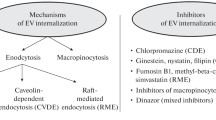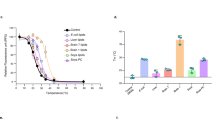Abstract
In order to use giant vesicles for substrate uptake studies in metabolically important tissues, we characterized giant vesicles isolated from heart, liver, skeletal muscle and adipose tissue. We investigated which cell types and which plasma membrane regions are involved in giant vesicle formation and we examined the presence of transporters for metabolic substrates. Analysis of giant vesicles with markers specific for distinct cell types and distinct domains of the plasma membrane reveals that the plasma membrane of parenchymal cells, but not endothelial cells, are the source of the vesicle membranes. In addition, plasma membrane regions enriched in caveolae and involved in docking of recycling vesicles from the endosomal compartment are retained in giant vesicles, indicating that KCl-induced alterations in recycling processes are involved in giant vesicle formation. Giant vesicles contain vesicular lumen consisting of the soluble constituents of the cytoplasm including, fatty-acid binding proteins. Furthermore, giant vesicles isolated from heart, liver, skeletal muscle and adipose tissue are similar in size (10–15 μm) and shape and do not contain subcellular organelles, providing the advantage that substrate fluxes in the different organs can be studied independently of the surface/volume ratio but most importantly in the absence of intracellular metabolism.
Similar content being viewed by others
References
Stremmel W: Fatty acid uptake by isolated heart myocytes represents a carrier-mediated transport process. J Clin Invest 81: 844–852, 1988
Sorrentino D, Stump D, Potter J, Robinson B, White R, Kiang CL, Berk PD: Oleate uptake by cardiac myocytes is carrier-mediated and involves a 40-kDa plasma membrane, fatty acid binding protein similar to that in liver, adipose tissue, and gut. J Clin Invest 82: 928–835, 1988
Luiken JJFP, van Nieuwenhoven FA, America G, van der Vusse GJ, Glatz JFC: Uptake and metabolism of palmitate by isolated cardiac myocytes from adult rats: Involvement of sarcolemmal proteins. J Lipid Res 38: 745–758, 1997
Fischer Y, Thomas J, Sevilla L, Muñoz P, Becker C, Holman G, Kozka I, Palacin M, Testar X, Kammermeier H, Zorzano A: Insulin-induced recruitment of glucose transporter 4 (GLUT4) and 129 GLUT1 in isolated rat cardiac myocytes. J Biol Chem 272: 7085–7092, 1997
Russell RR, Bergeron R, Shulman GI, Young LH: Translocation of myocardial GLUT4 and increased glucose uptake through activation of AMPK by AICAR. Am J Physiol 277: H643–H649, 1999
Juel C: Intracellular pH recovery and lactate efflux in mouse soleus muscles stimulated in vitro: The involvement of sodium/proton exchange and a lactate carrier. Acta Physiol Scand 132: 363–371, 1988
Grimdtlich GK, Barnard RJ, Kaplan SA, Sternlicht E: Insulin binding and glucose transport in rat skeletal muscle sarcolemmal vesicles. Am J Physiol 249: E398–E408, 1985
King PA, Hirshman MF, Horton ED, Horton ES: Glucose transport in skeletal muscle membrane vesicles from control and exercised rats. Am J Physiol 257: C1128–C1134, 1989
Juel C: Muscle lactate transport studies in sarcolemmal giant vesicles. Biochim Biophys Acta 1065: 15–20, 1991
Ahmed A, Taylor PM, Rennie MJ: Characteristics of glutamine transport in sarcolemmal vesicles from rat skeletal muscle. Am J Physiol 259: E284–E291, 1990
Van Amelsvoort JMM, Sips HJ, Van Dam K: Sodium-dependent alanine transport in plasma-membrane vesicles from rat liver. Biochem J 174: 1083–1086, 1978
Bersohn MM: Sodium pump inhibition in sarcolemma from ischemic rats. J Mol Cell Cardiol 27: 1483–1489, 1995
Berardi S, Stieger B, Hagenbuch B, Carafoli E, Krählenbühl S: Characterization of L-carnitine transport into rat skeletal muscle plasma membrane vesicles. Eur J Biochem 267: 1985–1994, 2000
Ploug T, Wojtazewski J, Kristiansen S, Hespel P, Galbo H, Richter EA: Glucose transport and transporters in muscle giant vesicles: Differential effects of insulin and contractions. Am J Physiol 264: E270–E278, 1993
Standen NB, Stanfield PR, Ward TA: Single-channel recording from membrane vesicles formed from skeletal muscle fibres of the frog (Rana temporaria). J Physiol 346: 81P, 1984
Luiken JJFP, Arumugam Y, Dyck DJ, Bell RC, Pelsers MML, Turcotte LP, Tandon NN, Glatz JFC, Bonen A: Increased rates of fatty acid uptake and plasmalemmal fatty acid transporters in obese Zucker rats. J Biol Chem 276: 40567–40573, 2001
McCullagh KJA, Juel C, O'Brien M, Bonen A: Chronic muscle stimulation increases lactate transport in rat skeletal muscle. Mol Cell Biochem 156: 51–57, 1996
Tokumaru H, Anzai K, Abe T, Kirino Y: Purification of the cardiac 1,4-dihydropyridine receptor using immunoaffinity chromatography with a monoclonal antibody against the alpha 2 delta subunit of the skeletal muscle dihydropyridine receptor. Eur J Pharmacol 227: 363–370, 1992
Van Nieuwenhoven FA, Verstijnen CP, van Eys GJ, van Breda E, De Jong, YF, van der Vusse GJ, Glatz JFCL: Fatty acid transfer across the myocardial capillary wall: No evidence of a substantial role for cytoplasmic fatty acid-binding protein. J Mol Cell Cardiol 26: 1635–1647, 1994
Luiken JJFP, Turcotte LP, Bonen A: Protein-mediated palmitate uptake and expression of fatty acid transport proteins in heart giant vesicles. J Lipid Res 40: 1007–1016, 1999
Berk PD, Zhou S-L, Kiang C-L, Stump D, Bradbury M, Isola L: Uptake of long chain free fatty acids is selectively up-regulated in adipocytes of Zucker rats with genetic obesity and non-insulindependent diabetes mellitus. J Biol Chem 272: 8830–8835, 1997
Bonen A, Luiken JJFP, Liu S, Dyck DJ, Kiens B, Kristiansen S, van der Vusse GJ, Glatz JFC: Palmitate transport and fatty acid transporters in red and white muscles. Am J Physiol 275: E471–E478, 1998
Schnitzer JE: Gp60 is an albumin-binding glycoprotein expressed by continuous endothelium involved in albumin transcytosis. Am J Physiol 262: H246–H254, 1992
Muñoz P, Mora S, Sevilla L, Kaliman P, Tomàs E, Gumà A, Testar X, Palacín, Zorzano A: Expression and insulin-regulated distribution of caveolin in skeletal muscle. J Biol Chem 271: 8133–8139, 1996
Kogo H, Fujimoto T: Caveolin-1 isoforms are encoded by distinct mRNAs. Identification of mouse caveolin-1 mRNA variants caused by alternative transcription initiation and splicing. FEBS Lett 465: 119–123, 2000
Oka N, Asai K, Kudej RK, Edwards JG, Toya Y, Schwencke C, Vatner DE, Vatner SF, Ishikawa Y: Downregulation of caveolin by chronic β-adrenergic receptor stimulation in mice. Am J Physiol 273: C1957–C1962, 1997
Song KS, Li S, Okamoto T, Quilliam LA, Sargiacomo M, Lisant MP: Co-purification and direct interaction of ras with caveolin, an integral membrane protein of caveolae microdomains, detergentfree purification of caveolae-membranes. J Biol Chem 271: 9690–9697, 1996
Song KS, Scherer PE, Tang ZL, Okamoto T, Li S, Chafel M, Chu C, Kohtz DS, Lisanti MP: Expression of caveolin-3 in skeletal, cardiac, and smooth muscle cells. J Biol Chem 271: 15160–15165, 1996
Knudsen KA, Soler AP, Johnson KR, Wheelock MJ: Interaction of α-catenin with the cadherin/catenin cell/cell adhesion complex via α-catenin. J Cell Biol 130: 67–77, 1995
Rimm DL, Koslov ER, Kebriaei P, Ciani CD, Morrow JS: Alphal(E)-catenin is an actin-binding and-bundling protein mediating the attachement of F-actin to the membrane adhesion complex. Proc Natl Acad Sci USA 92: 8813–8817, 1995
Imanaka-Yoshida K, Knudsen KA, Linask KK: N-cadherin is required for the differentiation and initial myofibrillogenesis of chick cardiomyocytes. Cell Motil Cytoskel 39: 52–62, 1998
Linnemann D, Gaardsvoll H, Dalseg AM, Zhernosekov D, Lundgren T, Edvardsen K, Bock E: Characterization of N-cadherin messenger RNA and polypeptide expression in rat. Int J Dev Neurosci 12: 441–450, 1994
Miyatani S, Shimamura K, Hatta M, Nagafuchi A, Nose A, Matsunaga M, Hatta K, Takeichi M: Neural cadherin: Role in selective cell-cell adhesion. Science 245: 631–635, 1989
Gustavsson J, Parpal S, Karlsson M, Ramsing C, Thorn H, Borg M, Lindroth M, Holmgren-Peterson K, Magnusson K-E, Strålfors P: Localisation of the insulin receptor in caveolae of adipocyte plasma membrane. FASEB J 13: 1961–1971, 1999
Torlinska T, Mackowiak P, Nogowski L, Nowak KW, Madry E, Perz M: Characteristics of insulin receptor binding to various rat tissues. J Physiol Pharmacol 49: 261–270, 1998
Kandror KV, Pilch PF: Compartmentalization of protein traffic in insulin-sensitive cells. Am J Physiol 271: E1–E14, 1996
Jefferies WA, Brandon MR, Williams AF, Hunt SV: Analysis of lymphopoietic stem cells with a monoclonal antibody to the rat transferrin receptor. Immunology 54, 333–341, 1985
Abumrad N, Coburn C, Ibrahimi A: Membrane proteins implicated in long-chain fatty acid uptake by mammalian cells: CD36, FATP and FABPm. Biochim Biophys Acta 1441: 4–13, 1999
Luiken JJFP, Schaap FG, van Nieuwenhoven FA, van der Vusse GJ, Bonen A, Glatz JFC: Cellular fatty acid transport in heart and skeletal muscle as facilitated by proteins. Lipids 34: S169–S175
Febbraio M, Hajjar DP, Silverstein RL: CD36: A class B scavenger receptor involved in angiogenesis, artherosclerosis, inflammation, and lipid metabolism. J Clin Invest 108: 785–791, 2001
Glatz JFC, Storch J: Unravelling the significance of cellular fatty acid-binding proteins. Lipidology 12: 267–274, 2001
Motojima K, Passilly P, Peters JM, Gonzalez FJ, Latruffe N: Expression of putative fatty acid transporter genes are regulated by peroxisome proliferator-activated receptor alpha and gamma activators in a tissue-and inducer-specific manner. J Biol Chem 273: 16710–16714, 1998
Brinkmann JFF: unpublished observations
Bonen A, Luiken JJFP, Arumugam Y, Glatz JFC, Tandon NN: Acute regulation of fatty acid uptake involves the cellular redistribution of fatty acid translocase. J Biol Chem 276: 14501–14508, 2000
Luiken JJFP, Willems J, van der Vusse GJ, Glatz JFC: Electrostimulation enhances FAT/CD36-mediated long-chain fatty acid uptake by isolated rat cardiac myocytes. Am J Physiol 281: E704–E712, 2001
Luiken JJFP, Dyck DJ, Tandon NN, Arumugam Y, Glatz JFC, Bonen A: Insulin translocates the fatty acid transporter FAT/CD36 to the plasma membrane. Am J Physiol (in press)
Stump DD, Zhou SL, Berk PD: Comparison of plasma membrane FABP and mitochondrial isoform of aspartate aminotransferase from rat liver. Am J Physiol 265: G894–902, 1993
Zorzano A, Sevilla L, Camps M, Becker C, Meyer J, Kammermeier H, Munoz P, Guma A, Testar X, Palacin M, Blasi J, Fischer Y: Regulation of glucose transport, and glucose transporters expression and trafficking in the heart: Studies in cardiac myocytes. Am J Cardiol 80: 65A–76A, 1997
Storch J, Thumser AE: The fatty acid transport function of fatty acid-binding proteins. Biochim Biophys Acta 1486: 28–44, 2000
Stremmel W, Berk PD: Hepatocellular influx of [14C]oleate reflects membrane transport rather than intracellular metabolism or binding. Proc Natl Acad Sci USA 83: 3086–3090, 1986
Mueckler M: Facilitative glucose transporters. Eur J Biochem. 219: 713–725, 1994
Kristiansen S, Hargreaves M, Richter EA: Exercise-induced increase in glucose transport, GLUT-4, and VAMP-2 in plasma membrane from human muscle. Am J Physiol 270: E197–201, 1996
Scherer PE, Lisanti MP, Baldini G, Sargiacomo M, Mastick CC, Lodish HF: Induction of caveolin during adipogenesis and association of GLUT4 with caveolin-rich vesicles. J Cell Biol 127: 1233–1243, 1994
Kandror KV, Stephens JM, Pilch PF: Expression and compartmentalization of caveolin in adipose cells: Coordinate regulation with and structural segregation from GLUT4. J Cell Biol 129: 999–1006, 1995
Author information
Authors and Affiliations
Rights and permissions
About this article
Cite this article
Koonen, D., Coumans, W., Arumugam, Y. et al. Giant membrane vesicles as a model to study cellular substrate uptake dissected from metabolism. Mol Cell Biochem 239, 121–130 (2002). https://doi.org/10.1023/A:1020549311455
Issue Date:
DOI: https://doi.org/10.1023/A:1020549311455




